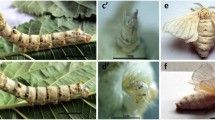Summary
In a survey of 21 strains of silkworm larvae for their phototactic behavior, most of them were found to give positive- or non-phototactic responses; only one strain, os; so, moved away from the light source (negative phototaxis). Genetic analysis of this negative-phototactic strain shows that mutation in the so gene (larval skin sooty black) or other gene(s) closely linked to the so gene is the principal factor affecting the orientation of the larvae when they are exposed to the light. The genetic trait of negative phototaxis is completely recessive to those of both positive and nonphototaxis. Mosaic analysis indicates that the brain is responsible for determining the orientation toward or away from the light.
Similar content being viewed by others
References
Bentley D (1975) Single gene cricket mutations: effects on behavior, sensillar, sensory neurones and identified interneurons. Science 180:760–764
Chikushi H (1972) Genes and genetical stocks of the silkworm. Keigaku Publishing Company, Tokyo
Garcia-Bellido A, Merriam JR (1969) Cell lineage of the imaginal disc in Drosophila gynandromorphs. J Exp Zool 170:61–76
Hall JC, Greenspan RJ (1979) Genetic analysis of Drosophila neurobiology. Annu Rev Genet 13:127–195
Hotta Y, Benzer S (1970) Genetic dissection of the Drosophila nervous system by means of mosaics. Proc Natl Acad Sci USA 67:1156–1163
Hotta Y, Benzer S (1972) Mapping of behaviour in Drosophila mosaics. Nature 240:527–535
Inoko H, Katsuki M, Watanabe I (1981) Suppression of phototaxis in silkworm larvae. Anim Behav 29:873–877
Inoko H (1982) Role of tactile signals in courtship behavior of Bombyx mori. Jap J Appl Ent Zool 26:10–14
Katsuki M (1980) Fate mapping of several tissues and sexual behavior in genetic mosaics of silkworm, Bombyx mori. Thesis Kyushu Univ
Katsuki M, Murakami A, Watanabe I (1980) Fate mapping of some tissues in the genetic mosaics of the silkworm, Bombyx mori. Zoological Magazine 89:269–276
Shimizu I, Kitabatake S, Kato M (1976) Loss of phototactic behavior in silkworm larvae reared on synthetic diet. Proc Japan Acad 52:137–140
Shimizu I, Kato M (1978) Loss of phototaxis in silkworm larvae after smelling mulberry leaves and recovery after electroconvulsive shock. Nature 272:248–249
Sturtevant AH (1929) The claret mutant type of Drosophila simulans: a study of chromosomal elimination and cell lineage. Z Wiss Zool 135:323–356
Tamazawa S (1977) Effect of supercooling on silkworm eggs. Res Bull Univ Farm Hokkaido Univ 20:145–152
Quinn WG, Sziber PP, Booker R (1979) The Drosophila memory mutant amnesiac. Nature 277:212–214
Author information
Authors and Affiliations
Additional information
Communicated by O. Siddiqi
Rights and permissions
About this article
Cite this article
Inoko, H., Katsuki, M. & Watanabe, I. Genetic and mosaic analysis of negative-phototactic behavior in silkworm larvae. Mol Gen Genet 190, 112–116 (1983). https://doi.org/10.1007/BF00330331
Received:
Issue Date:
DOI: https://doi.org/10.1007/BF00330331




